Methods and compositions of a storable relatively lightweight proppant slurry for hydraulic fracturing and gravel packing applications
a technology of hydraulic fracturing and gravel packing, which is applied in the direction of fluid removal, chemistry apparatus and processes, borehole/well accessories, etc., can solve the problems of proppant pack and/or formation damage, interference with proper placement downhole, and formation damage. , to achieve the effect of improving the overall system performan
- Summary
- Abstract
- Description
- Claims
- Application Information
AI Technical Summary
Benefits of technology
Problems solved by technology
Method used
Image
Examples
example 1
Conductivity tests were performed according to API RP 61 (1st Revision, Oct. 1, 1989) using an API conductivity cell with Ohio sandstone wafer side inserts. Each particulate material sample was loaded into the cell and closure stress applied to the particulate material using a “DAKE” hydraulic press having a “ROSEMOUNT” differential transducer (#3051C) and controlled by a “CAMILE” controller. Also employed in the testing was a “CONSTAMETRIC 3200” constant rate pump which was used to flow deionized water through each particulate sample.
The coated ground walnut particulate material employed was ground walnut hulls from “COMPOSITION MATERIALS, INC.” having a size of about 12 / 20 mesh and having an in situ Young's modulus of from about 1,000,000 psi to about 2,000,000 psi. The ground walnut particulate material was coated with a layer of BORDEN “SIGMASET LV” low volatility resin in an amount of about 12% by weight of total particulate weight, and the particles were manufactured by “BO...
example 2
Using a procedure similar to that of Example 1, the same type of 12 / 20 mesh ground walnut hull core material was tested with different types of resin layers from BORDEN. Testing was carried out for all samples at 150° F. and closure stresses ranging from 500 psi to 2000 psi. For two of samples, testing was also carried out at 200° F. and closure stress of 2200 psi. Resin type and amounts used in each sample are identified in Table IV. Results of this testing is given in Tables V and VI, and in FIGS. 5 and 6.
TABLE IVBORDEN Resin Layers on 12 / 20 MeshGround Walnut Shell MaterialLayer Type and Amount (%by Weight of Total WeightSample Identifierof Particle)*AInner layer of 2% by weightBORDEN “2AC” with OuterLayer of 4% by weightBORDEN “SIGMASET LV”BLayer of 6% by weightBORDEN “SIGMASET LV”resin (Coated particles havingBorden identification code“66040”)CLayer of 6% by weightBORDEN “SIGMASET LV”resin (Coated particles havingBorden identification code“66535”)DBORDEN Two Coat Resin —Inner...
example 3
Using a procedure similar to that of Example 1, conductivity tests were performed on three different samples of 12 / 20 mesh ground walnut shells at 150° F. and at a concentration of 1 lb / ft2: Sample A (treated with inner layer of phenol formaldehyde resin and outer layer of urethane epoxy resin); Sample B (soaked for 4 hours at room temperature in FSA-1 siloxane-based compound); and Sample C (spray treated with FSA-1 in an amount of 26% by weight of the ground walnut hull material). The particles of Samples A and C were manufactured by FRITZ, while the particles of Sample B were manufactured in the laboratory. Results of this testing is shown in Table VII and FIG. 7.
TABLE VIIPermeability, DarciesClosureStress, psiSample ASample BSample C10009124025020008617012030003010080
FIG. 7 shows the permeability of the ground walnut hull materials of the three samples of this example at 500, 1000 and 2000 psi closure stresses and 150° F.
The results of this example illustrate how ground waln...
PUM
 Login to View More
Login to View More Abstract
Description
Claims
Application Information
 Login to View More
Login to View More - R&D
- Intellectual Property
- Life Sciences
- Materials
- Tech Scout
- Unparalleled Data Quality
- Higher Quality Content
- 60% Fewer Hallucinations
Browse by: Latest US Patents, China's latest patents, Technical Efficacy Thesaurus, Application Domain, Technology Topic, Popular Technical Reports.
© 2025 PatSnap. All rights reserved.Legal|Privacy policy|Modern Slavery Act Transparency Statement|Sitemap|About US| Contact US: help@patsnap.com



